Entries from April 27, 2014 - May 3, 2014
UK monetary conditions excessively loose
UK narrow money continues to expand rapidly, signalling stable, solid economic growth through late 2014. Households, meanwhile, are still withdrawing large sums from savings accounts in response to low deposit interest rates. This outflow is a direct consequence of Bank of England policy and may be contributing to excessive consumer spending and financial speculation / asset bubbles, with negative medium-term economic consequences.
Six-month expansion of real narrow money* moved from moderate to strong between mid-2012 and spring 2013, correctly signalling an upshift in economic growth from the start of last year, allowing for the usual half-year lead. It has since stabilised at a robust pace, with today’s March result continuing the trend – see chart. Quarterly GDP growth has been 0.7-0.8% in each of the last four quarters and is likely to be similar over the remainder of 2014.
Real broad money** expansion is also stable but at a subdued level by past standards. This has not prevented strong economic growth because the demand to hold broad money has fallen in response to low deposit interest rates.
Households, for example, put only £435 million into cash ISAs in March, the lowest since May 2011, while withdrawing £1.9 billion from time deposits. Such deposits have suffered a cumulative outflow of £34.2 billion over the last 12 months, equivalent to about 3% of household disposable income over the period – second chart.
Real broad credit remains stagnant, providing further proof of its irrelevance for short-run economic prospects. Arranged but undrawn credit facilities, however, have been rising, suggesting a gradual lending revival.
A monthly fall of 0.1% in the Bank’s favoured broad money measure, M4ex, may attract attention. This was, however, caused by the Debt Management Office issuing Treasury bills and borrowing in the repo market to finance a large gilt redemption. This operation is temporary and M4ex will expand as the borrowing is unwound.
*Real non-financial M1, i.e. currency and overnight deposits of households and non-financial firms deflated by consumer prices.
**Real non-financial M4.
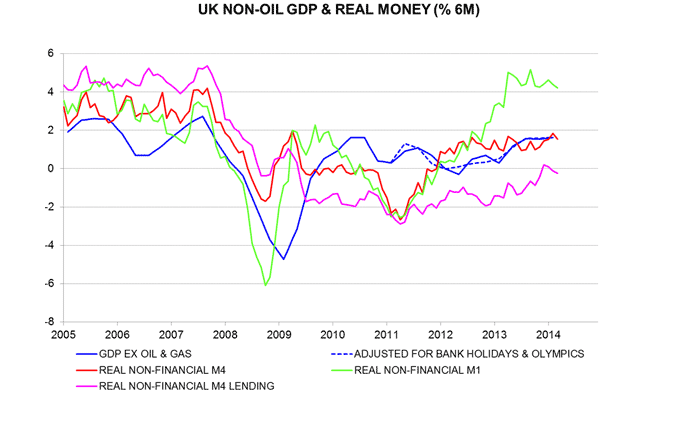
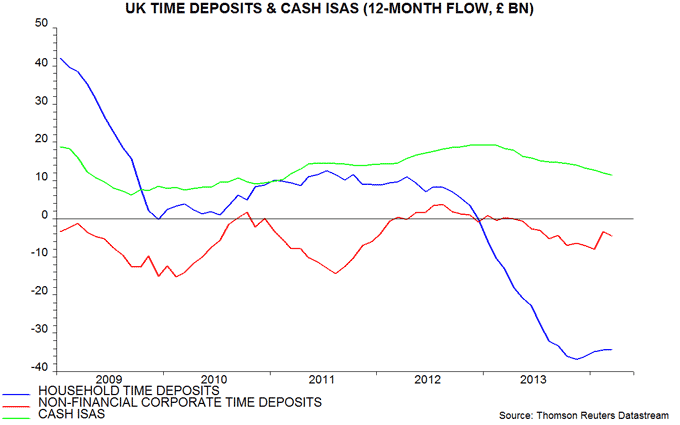
Global growth rebound on track despite weak Japan
Recent news is consistent with the forecast here that global economic momentum will reach a short-term low in May and rebound over the summer.
Six-month growth in global* industrial output is estimated to have stabilised in March after falls in January and February, based on data covering two-thirds of the aggregate – see chart. A further decline is likely in April / May, partly reflecting lower production in Japan following the recent sales tax rise. Japanese manufacturers expect to cut output by 1.3% between March and May, with a larger reduction suggested by a plunge in purchasing managers’ new orders.
The forecast of global economic reacceleration from May rests on a pick-up in real narrow money expansion since late 2013 and a more recent confirming rise in the longer leading indicator monitored here. A definitive March reading of the leading indicator will be available on 13 May but preliminary data suggest another monthly gain – an estimate is included in the chart. The recent low in the indicator, meanwhile, may be revised from January to December. This would be consistent with a May trough in industrial output growth, allowing for the typical 4-5 month lead.
Global real money expansion stabilised at a solid level in March, implying favourable economic prospects through September, at least. The recent pick-up has been driven by the US; Japanese real money, by contrast, will be squeezed temporarily by the inflation boost from the sales tax rise – second chart**. The Japan effect could lower the global aggregate from April.
The prospect of a summer economic rebound may warrant a more cyclical bias in equity portfolios: stocks in cyclical industries tend to outperform non-cyclicals when the leading indicator rises significantly – third chart.
*G7 developed and E7 emerging economies.
**Includes April forecasts for US and Japan.
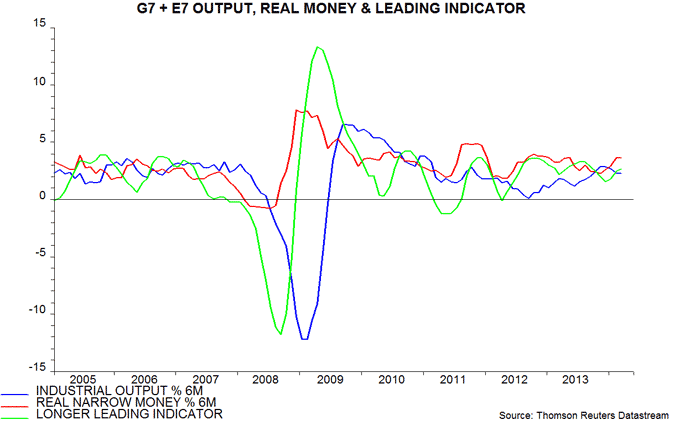
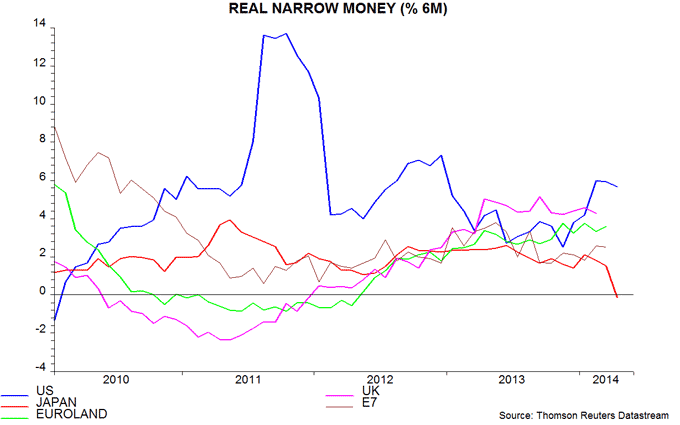
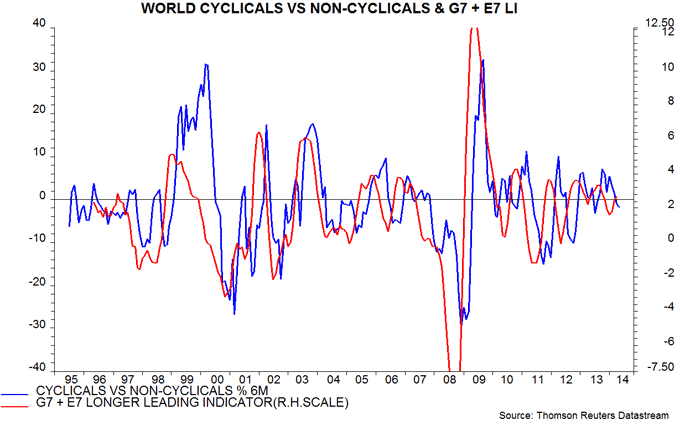
Eurozone narrow money trends still positive
The “monetarist” rule is that money supply changes lead activity by about six months and inflation by about two years. The forecasting approach here emphasises narrow money – currency plus sight deposits – when applying the rule. This approach was the basis for forecasts that the Eurozone economy would recover from late 2012 and inflation would bottom around end-2013, reviving in 2014-15.
The first forecast has proved correct and current monetary trends point to the economic upswing continuing through late 2014, at least. The “flash” April purchasing managers’ output index released last week was the highest since May 2011 and consistent with quarterly GDP growth of about 0.5% (not annualised). Six-month real narrow money* expansion remains robust, according to March statistics released today – see first chart.
The jury has yet to return a verdict on the inflation forecast. The annual increase in core consumer prices – excluding energy, food, alcohol and tobacco – fell to 0.7% in December 2013 and revisited this level in March, partly reflecting a drag from Easter timing effects. The expectation here remains for a gradual recovery in price pressures through 2014.
Real money** growth was much weaker in peripheral economies than in the core grouping over 2010-12 but this gap closed in late 2013 and recent trends remain similar – second chart. The message is that economic recovery is now broadly-based across countries, increasing confidence in its sustainability.
The final chart shows real money growth in the big four economies. The range is unusually narrow, signalling similar economic prospects. The most notable recent change is a pick-up in France, suggesting that economic news will surprise positively later in 2014.
Broad money and credit trends remain weak but neither predicted the extent of the recent economic recovery. The demand to hold broad money has been depressed by falling deposit interest rates*** while bank lending is loosely correlated with the economic cycle, with a tendency to lag.
*Real non-financial M1, i.e. currency and overnight deposits of households and non-financial firms deflated by consumer prices.
**Real non-financial M1 is not available by country; the second and third charts refer to real overnight deposits and include holdings of non-bank financial firms.
***Equivalently, the velocity of circulation of broad money has risen.



